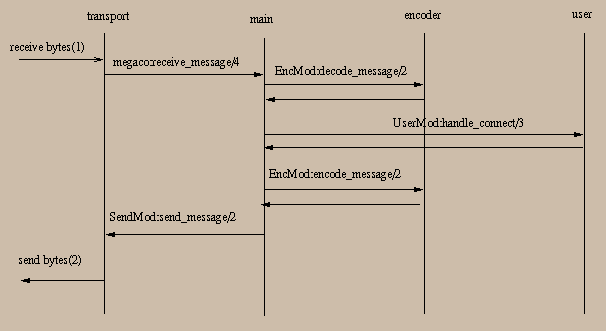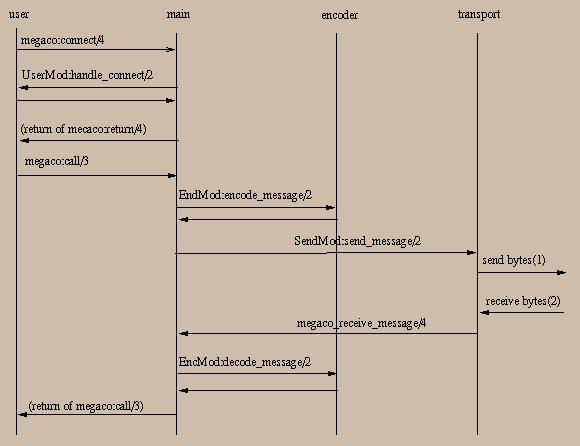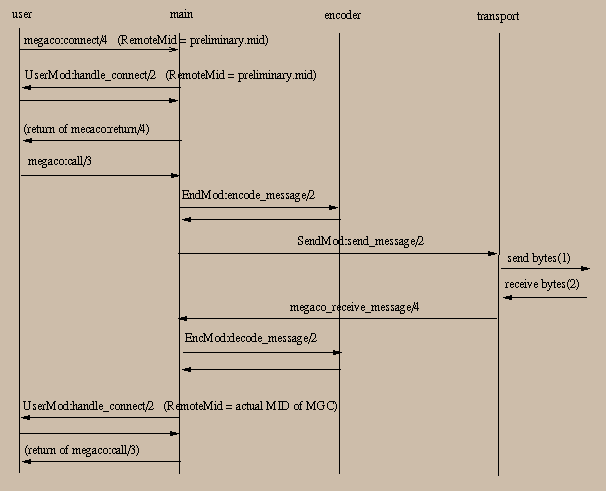![[Ericsson AB]](min_head.gif)
![[Ericsson AB]](min_head.gif)
A user may have a number of "virtual" connections to other users. An MG is connected to at most one MGC, while an MGC may be connected to any number of MG's. For each connection the user selects a transport service, an encoding scheme and a user callback module.
An MGC must initiate its transport service in order to listen to MG's trying to connect. How the actual transport is initiated is outside the scope of this application. However a send handle (typically a socket id or host and port) must be provided from the transport service in order to enable us to send the message to the correct destination. We do however not assume anything about this, from our point of view, opaque handle. Hopefully it is rather small since it will passed around the system between processes rather frequently.
A user may either be statically configured in a .config file according to the application concept of Erlang/OTP or dynamically started with the configuration settings as arguments to megaco:start_user/2. These configuration settings may be updated later on with megaco:update_conn_info/2.
The function megaco:connect/4 is used to tell the Megaco application about which control process it should supervise, which MID the remote user has, which callback module it should use to send messages etc. When this "virtual" connection is established the user may use megaco:call/3 and megaco:cast/3 in order to send messages to the other side. Then it is up to the MG to send its first Service Change Request message after applying some clever algorithm in order to fight the problem with startup avalanche (as discussed in the RFC).
The originating user will wait for a reply or a timeout (defined by the request_timer). When it receives the reply this will optionally be acknowledged (regulated by auto_ack), and forwarded to the user. If an interim pending reply is received, the long_request_timer will be used instead of the usual request_timer, in order to enable avoidance of spurious re-sends of the request.
On the destination side the transport service waits for messages. Each message is forwarded to the Megaco application via the megaco:receive_message/4 callback function. The transport service may or may not provide means for blocking and unblocking the reception of the incoming messages.
If a message is received before the "virtual" connection has been established, the connection will be setup automatically. An MGC may be real open minded and dynamically decide which encoding and transport service to use depending on how the transport layer contact is performed. For IP transports two ports are standardized, one for textual encoding and one for binary encoding. If for example an UDP packet was received on the text port it would be possible to decide encoding and transport on the fly.
After decoding a message various user callback functions are invoked in order to allow the user to act properly. See the megaco_user module for more info about the callback arguments.
When the user has processed a transaction request in its callback function, the Megaco application assembles a transaction reply, encodes it using the selected encoding module and sends the message back by invoking the callback function:
Re-send of messages, handling pending transactions, acknowledgements etc. is handled automatically by the Megaco application but the user is free to override the default behaviour by the various configuration possibilities. See megaco:update_user_info/2 and megaco:update_conn_info/2 about the possibilities.
When connections gets broken (that is explicitly by megaco:disconnect/2 or when its controlling process dies) a user callback function is invoked in order to allow the user to re-establish the connection. The internal state of kept messages, re-send timers etc. is not affected by this. A few re-sends will of course fail while the connection is down, but the automatic re-send algorithm does not bother about this and eventually when the connection is up and running the messages will be delivered if the timeouts are set to be long enough. The user has the option of explicitly invoking megaco:cancel/2 to cancel all messages for a connection.
In order to prepare the MGC for the reception of the initial message, hopefully a Service Change Request, the following needs to be done:
When the initial message arrives the transport service forwards it to the protocol engine which automatically sets up the connection and invokes UserMod:handle_connect/2 before it invokes UserMod:handle_trans_request/3 with the Service Change Request like this:

In order to prepare the MG for the sending of the initial message, hopefully a Service Change Request, the following needs to be done:
If the MG has been provisioned with the MID of the MGC it can be given as the RemoteMid parameter to megaco:connect/4 and the call flow will look like this:

If the MG cannot be provisioned with the MID of the MGC, the MG can use the atom 'preliminary_mid' as the RemoteMid parameter to megaco:connect/4 and the call flow will look like this:

There are three kinds of configuration:
The initial configuration of the Megaco should be defined in the Erlang system configuration file. The following configured parameters are defined for the Megaco application:
users = [{Mid, [user_config()]}]. {Item, Value}).scanner = flex | {Module, Function, Arguments, Modules}flex will result in the start of the flex scanner.supervisor:start_child for an explanation of the
parameters).The configuration can be changed during runtime. This is done with the functions megaco:update_user_info and megaco:update_conn_info
The transaction sender is a process (one per connection), which handle all transaction sending, if so configured (see megaco:user_info and megaco:conn_info).
The purpose of the transaction sender is to accumulate transactions for a more efficient message sending. The transactions that are accumulated are transaction request and transaction ack. For transaction ack's the benefit is quite large, since the transactions are small and it is possible to have ranges (which means that transaction acks for transactions 1, 2, 3 and 4 can be sent as a range 1-4 in one transaction ack, instead of four separate transactions).
There are a number of configuration parameter's that control the operation of the transaction sender. In principle, a message with everything stored (ack's and request's) is sent from the process when:
trans_timer expires.trans_ack_maxcount number of ack's has been
received.trans_req_maxcount number of requests's has
been received.trans_req_maxsize.When something is to be sent, everything is packed into one message.
Unless the trigger was a reply transaction and the added size of the
reply and all the requests is greater then trans_req_maxsize,
in which case the stored transcations is sent firts in a separate
mesage, and the the reply in another message.
When the transaction sender receives a request which is already
"in storage" (indicated by the transaction id) it is assumed to
be a resend and everything stored is sent. This could happen if
the values of the trans_timer and the request_timer
is not properly choosen.